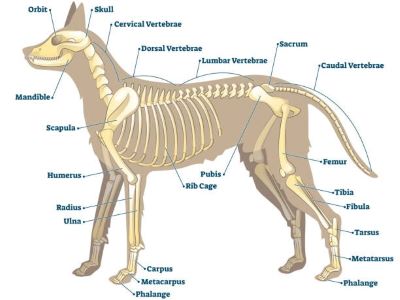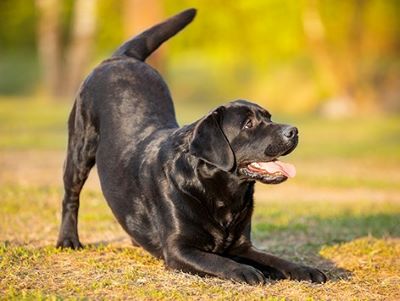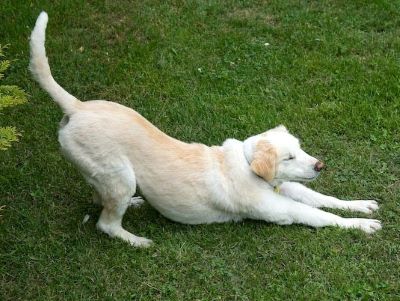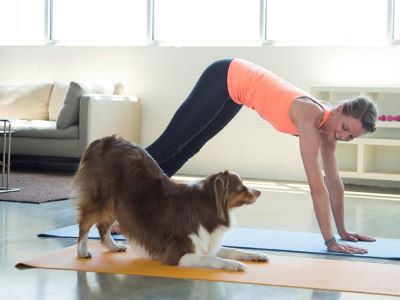Stretching is a common behavior observed in dogs, often leaving us wondering why they engage in this seemingly routine activity. Similar to humans, dogs stretch by extending their muscles and joints to their full length.

This peculiar behavior serves various purposes and plays a crucial role in their overall well-being. Understanding the reasons behind a dog’s frequent stretching can provide valuable insights into their physical and mental health.
Therefore, this article aims to explore the reasons why does my dog stretch so much and shed light on the benefits this activity brings to our beloved furry companions.
Contents
Understand Why Does My Dog Stretch so Much?
Investigate the causes of your dog’s excessive stretching if you find yourself wondering why they do it. We can decipher the physiological and natural features of dog stretching by comprehending the underlying reasons.
The Anatomy and Physiology of Dog Stretching
- Stretching is a common behavior observed in dogs, serving various physiological functions. This activity involves a coordinated effort of several muscles, joints, and nerves.
- Understanding the anatomy and physiology of dog stretching can shed light on its purpose and benefits.[1]
- In dog stretching, multiple muscle groups work together to extend and flex different parts of the body, including the trapezius, latissimus dorsi, gluteal muscles, quadriceps, hamstrings, and calf muscles.

- These muscles elongate and contract, allowing dogs to stretch their limbs and spine.
- The joints, such as the shoulder, elbow, hip, stifle (knee), and tarsal (ankle) joints, play a crucial role in facilitating these stretching movements by providing the necessary range of motion.
- Additionally, synovial fluid lubricates the joints, ensuring smooth and frictionless movements.
The coordination of stretching is made possible by sensory nerves that detect changes in muscle length and tension, sending signals to the brain. Motor nerves then stimulate the muscles, enabling the desired stretching actions.
The Hormones, Neurotransmitters, and Endorphins Released by Stretching
- The release of numerous hormones, neurotransmitters, and endorphins is influenced by stretching, which benefits a dog’s general health.
- Stretching can encourage the release of endorphins in dogs. Endorphins are organic sedatives and mood elevaters that increase pleasure and lessen suffering.
- They assist dogs in lowering tension, elevating mood, and relaxing more.
- Stretching can also alter a dog’s hormone levels. For instance, stretching causes the production of cortisol, sometimes known as the stress hormone, by activating the hypothalamic-pituitary-adrenal (HPA) axis.
- Modest stretching, however, can support a healthy stress response by regulating cortisol levels.
Stretching affects the brain’s neurotransmitters as well. Stretching can cause the release of serotonin, a neurotransmitter linked to mood control and feelings of well-being. This may help dogs feel more relaxed and comfortable all around.
The Signs of Healthy and Unhealthy Stretching in Dogs
Dogs often engage in healthful stretching, which offers several advantages for both their physical and mental wellbeing. But not all stretching is created equal.
Stretching might be a sign that your dog is ill or uncomfortable. In this part, we’ll examine the indicators of both good and harmful stretching in dogs, as well as when to have your dog’s stretching problems seen by a vet.
Healthy Dog Stretching: Smooth, Fluid, and Balanced Movements
Healthy stretching is when your dog stretches their muscles, joints and nerves in a smooth, fluid and balanced way. Healthy stretching helps your dog to improve their flexibility, mobility, circulation, mood and well-being.
Healthy stretching also helps your dog to prepare their body for physical activity or relaxation. Some examples of healthy stretching are:
a). The play bow stretch: In bowing stretching position, your dog keeps their back legs and chest up while lowering their front legs and chest to the ground.
This stretch either shows surrender or encourages play from other dogs. Moreover, it conveys delight, wonder, or enthusiasm.

b). The pandiculation stretch: Your dog will accomplish this by opening their lips wide and extending their limbs in various directions.
By sequentially tightening and releasing their muscles, this stretch resets and reboots their muscular system. Moreover, it exudes power or assurance.
c). The spinal twist stretch: Your dog does this by lying on their back and twisting their spine to one side while maintaining a straight leg position.
This stretching exercise increases the spine’s range of motion and releases tension in the back muscles. It also denotes confidence or ease.
Unhealthy Dog Stretching: Excessive, Repetitive, or Asymmetrical Movements
Unhealthy stretching is when your dog stretches their muscles, joints or nerves in an excessive, repetitive or asymmetrical way.
Unhealthy stretching may indicate that your dog is feeling pain, discomfort or stress. Unhealthy stretching may also worsen an existing condition or injury. Some examples of unhealthy stretching are:
a). The praying position: This is when your dog stretches their front legs out in front of them while keeping their rear end up in the air.
This stretch may indicate that your dog has an upset stomach, bloating or pancreatitis. It may also indicate that your dog is feeling anxious or fearful.
b). The dragging position: This is when your dog drags their hind legs behind them while moving forward with their front legs.
This stretch may indicate that your dog has a spinal injury, hip dysplasia or arthritis. It may also indicate that your dog is feeling insecure or submissive.

c). The limping position: This is when your dog favors one leg over the other while walking or standing. This stretch may indicate that your dog has a sprain, strain or fracture in their leg.
It may also indicate that your dog is feeling pain or inflammation.
Seek Professional Help for Dogs Stretching Issues
If you notice any signs of unhealthy stretching in your dog, you should take them to the vet as soon as possible.
Your vet can examine your dog and diagnose the cause of their stretching issues. Your vet can also prescribe the appropriate treatment for your dog’s condition.
Some signs that you should seek professional help for your dog’s stretching issues are:
- Your dog stretches excessively, repetitively or asymmetrically.
- Your dog stretches along with other signs of pain, such as whining, limping, licking or biting.
- Your dog stretches along with other signs of illness, such as vomiting, diarrhea, fever or loss of appetite.
- Your dog’s stretching does not improve after a few days or worsens over time.
- Your dog’s stretching interferes with their normal activities or quality of life.
The Benefits of Stretching for Dogs
If you have ever seen your dog stretch after a nap or a long walk, you may have wondered why they do it. Stretching is not only a natural and instinctive behavior for dogs, but also a beneficial one that can improve their health and well-being in many ways.[2]
Here are some of the benefits of stretching for dogs:
Stretching Improves Flexibility, Mobility and Circulation

- Stretching has three key effects: improving relaxation, happiness, and interpersonal relationships; restoring flexibility and range of motion; and preventing injuries and stiffness.
- The range of motion in a dog’s joints might be reduced as it ages or if it is an athletic canine that exercises frequently. Lack of flexibility and slower, less fluid movement may result from this.
- By extending shortened muscles that pull parts of the body away from the dog’s ideal posture, stretching can assist in restoring it. It has been demonstrated that stretching increases blood flow to and from the muscles.
- More oxygen and nutrients are given to the muscles and more waste items are eliminated when there is increased blood flow. This can lessen discomfort and inflammation while also enhancing the health and performance of the muscles.
Stretching Prevents Injuries, Stiffness, and Pain
- By preparing the muscles for action and lowering the chance of muscular tears, strains, and sprains, stretching can assist to avoid injuries.
- By maintaining the muscles loose and flexible and preventing them from getting tight and constricted, stretching can also assist to avoid stiffness.
- By easing muscular tension, spasms, and cramps, which can be uncomfortable and restrict mobility. Stretching can also assist to avoid pain.
- By releasing endorphins, which are naturally occurring medicines that also enhance happiness and wellbeing, stretching can also assist to reduce pain.
Stretching Enhances Relaxation, Mood and Bonding
- Stretching helps improve relaxation by soothing the nervous system and lowering stress hormones, which can negatively affect behavior and health.
- Stretching can also improve mood by encouraging the production of serotonin, dopamine, and oxytocin, neurotransmitters that foster pleasure, happiness, and social connection.[3]
- By fostering a healthy relationship between you and your dog that is built on trust, respect, and affection, stretching may also help to strengthen the link between you two.
- By enabling you to interpret your dog’s cues, indications, and preferences and respond appropriately, stretching may also improve communication.
The Ways to Support Your Dog’s Stretching Habits
In this section, we will look at some ways to provide a comfortable and safe environment for your dog to stretch, respect your dog’s boundaries and preferences when stretching, and join your dog in some stretching exercises to bond and have fun.

a) Provide a comfortable and safe environment for your dog to stretch: One of the ways to support your dog’s stretching habits is to provide them with a comfortable and safe environment where they can stretch without any distractions or interruptions.
Some tips to create such an environment are:
- Choose a quiet and spacious area where your dog can stretch freely without bumping into furniture or other objects.
- Provide your dog with a soft and cozy surface to stretch on, such as a rug, a mat, or a bed.
- Avoid exposing your dog to loud noises, bright lights, or sudden movements that may startle them or make them feel anxious while stretching.
- Keep other pets or children away from your dog while they are stretching, unless they are calm and respectful of your dog’s space.
- Praise your dog for stretching and reward them with treats or toys after they finish.
b). Respect your dog’s boundaries and preferences when stretching: Respecting your dog’s limits and preferences when they are stretching is another technique to encourage their stretching behavior.
During stretching, some dogs could appreciate being petted or massaged while others might prefer to stretch alone. Some dogs might stretch just sometimes, while others could stretch many times throughout the day.
Depending on their requirements or disposition, some dogs may stretch in various ways or postures.
Here are some tips for respecting your dog’s restrictions and preferences:
- Observe your dog’s mood and comfort level when stretching and act accordingly.
- Ask for your dog’s consent before touching or massaging them while stretching and respect their decision.
- Follow your dog’s preferences and needs when it comes to the frequency and duration of their stretching sessions and avoid interfering with them.
- Appreciate your dog’s uniqueness and diversity when it comes to their stretching habits and avoid comparing or judging them.
c). Join your dog in some stretching exercises to bond and have fun: Participating with your dog in stretching activities may strengthen your relationship and be enjoyable, which is a third technique to enhance their stretching routine.

Your physical and emotional health, as well as the bond you have with your dog, may all benefit from stretching together.
Here are some tips for engaging your dog in some stretching exercises:
- Choose simple and safe stretches to do with your dog or seek professional advice.
- Start with a light warm-up session to prepare your muscles for stretching.
- Follow your dog’s lead and comfort level when doing the stretches and avoid forcing or hurting them.
- End with a gentle cool-down session to relax and bond with your dog.
FAQs
Why does my dog keep stretching in front of me?
Dogs may stretch in front of their owners as a gesture of comfort and trust, indicating their relaxation and desire for positive interaction.
Why does my dog keep doing downward dog stretch?
Dogs perform the downward dog stretch to elongate their spine, stretch their leg and shoulder muscles, and relieve tension in their body, contributing to flexibility and circulation.
Do dogs stretch when they are in pain?
Dogs may stretch when they are in pain as a temporary means to reduce muscle tension and improve blood flow, although stretching alone does not always indicate pain. Consulting a veterinarian is advised for any concerns.
Why does my dog stretch on me?
Dogs may stretch on or near their owners as a display of affection and a desire for closeness, signifying a sense of security and a bonding opportunity.
Conclusion
In conclusion, we have answered the main question of why does my dog stretch so much and what it means for their health and well-being.
Understanding your dog’s stretching behavior and needs is crucial for their well-being. By debunking misconceptions and myths, we recognize that stretching is a natural behavior that helps dogs maintain flexibility and relieve muscle tension.
- Providing a comfortable environment, respecting boundaries, and engaging in bonding activities support their stretching habits.
- Observing and appreciating their stretching behavior allows us to provide the care they need.
Strengthening this bond enhances their overall health and happiness, creating a deeper connection between you and your furry companion.
References:
- Micheau, A., & Hoa, D. (2022, October 7). Anatomy of the dog – Illustrated atlas. IMAIOS. Retrieved July 8, 2023, from – IMAIOS
- Bergh, A., Asplund, K., Lund, I., Boström, A., & Hyytiäinen, H. K. (2022). A Systematic Review of Complementary and Alternative Veterinary Medicine in Sport and Companion Animals: Soft Tissue Mobilization. Animals, 12(11), 1440. – MDPI
- Raypole, C. (2022, July 26). How to Hack Your Hormones for a Better Mood. Healthline. Retrieved July 8, 2023, from – Healthline

When it comes to dogs, Julia ignores nothing. Being an animal behaviorist, dog trainer and a dog parent she knows exactly how even a tiny change in a dog’s surroundings and diet can leave dogs disturbed for a longer duration. Hence, she always makes sure to review for us only the best products for dogs out there.

